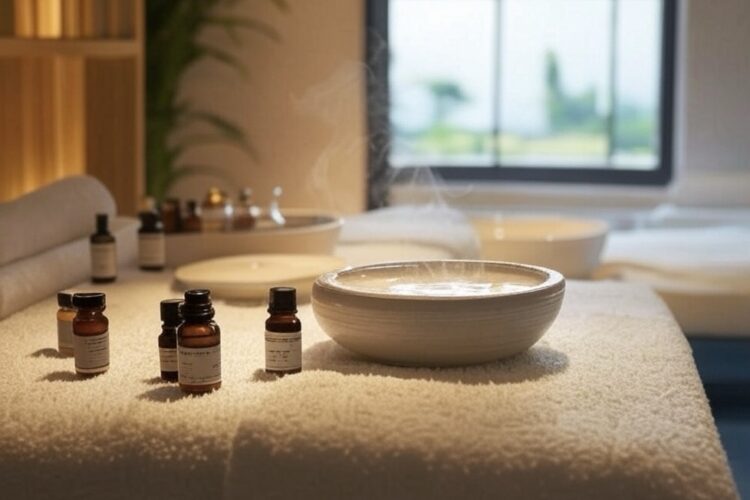Facial steaming is a simple, effective skincare practice that cleanses, hydrates, and rejuvenates skin. Warm steam opens pores, softens sebum, and boosts circulation, aiding blackhead removal, acne treatment, and skin hydration. To steam at home, cleanse your face, boil water, and sit 8–12 inches from the steam for 5–10 minutes, using a towel to trap vapor. Add essential oils like tea tree or chamomile for aromatherapy benefits. Electric facial steamers offer nano-ionic steam for deeper penetration. Steam 1–2 times weekly, but avoid over-steaming to prevent dryness. Sensitive skin or conditions like rosacea require caution—consult a dermatologist. Post-steam, rinse, exfoliate, and moisturize for optimal results. Facial steaming enhances product absorption, promotes relaxation, and supports sinus relief, making it a versatile addition to any beauty routine.
Long Version
Facial steaming, also known as face steam or steam therapy, has become a cornerstone of modern skincare routines, offering a spa-like experience at home. This time-honored practice, rooted in ancient beauty rituals, leverages the power of warm vapor to cleanse, hydrate, and rejuvenate the skin. Whether you’re aiming for pore cleansing, blackhead removal, or a moment of relaxation, facial steaming delivers a multitude of benefits. In this comprehensive guide, we’ll explore every facet of facial steaming—its benefits, techniques, tools, precautions, and more—to provide you with an authoritative resource for elevating your skin health.
What is Facial Steaming?
Facial steaming involves exposing the face to warm, moist vapor, typically generated by boiling water or an electric facial steamer. The steam softens the skin, opens pores, and promotes a deep cleansing effect, making it an ideal prep for exfoliation or comedone extraction. Beyond its cleansing prowess, facial steaming boosts circulation, hydrates the skin, and creates a soothing, spa treatment atmosphere. It’s a versatile practice suitable for most skin types when done correctly, offering both aesthetic and therapeutic benefits like sinus relief and relaxation.
The Science Behind Facial Steaming
The efficacy of facial steaming lies in its ability to interact with the skin’s physiology. Warm steam increases skin temperature, prompting blood vessels to dilate and enhancing circulation. This boost in blood flow delivers oxygen and nutrients to skin cells, promoting a radiant complexion and skin rejuvenation. Steam also softens sebum—the oily substance that clogs pores—making it easier to remove blackheads and impurities. Additionally, the moisture from steam hydrates the skin barrier, improving its elasticity and preparing it for subsequent skincare steps like moisturizer application or mask treatments.
For those incorporating aromatherapy steam, the addition of essential oils or herbal steam (like chamomile or lavender) can amplify benefits. These ingredients release anti-inflammatory and calming properties, reducing redness and soothing sensitive skin. Nano-ionic steam, produced by advanced electric facial steamers, consists of smaller water particles that penetrate deeper into the skin, enhancing hydration and detoxification.
Benefits of Facial Steaming
Facial steaming offers a wide array of benefits, making it a favorite in both professional spas and at-home routines:
- Deep Cleansing and Pore Opening: Steam loosens dirt, makeup, and excess sebum, facilitating pore cleansing and reducing the risk of acne breakouts.
- Blackhead Removal: By softening sebum, steam simplifies comedone extraction, helping clear blackheads without aggressive scrubbing.
- Skin Hydration: The hydrating mist of steam replenishes moisture, combating dryness and improving skin texture.
- Enhanced Product Absorption: Open pores allow serums, moisturizers, and masks to penetrate more effectively, maximizing their benefits.
- Circulation Boost: Increased blood flow promotes a healthy glow and supports skin tone evening.
- Relaxation and Stress Relief: The warmth and optional aromatherapy create a calming, spa-like experience, reducing stress.
- Sinus Relief: Steam can alleviate congestion, making it a dual-purpose treatment for skincare and respiratory comfort.
- Anti-Inflammatory Benefits: Herbal or essential oil-infused steam, such as tea tree oil or chamomile, soothes inflammation and redness.
- Exfoliation Prep: Softened skin is easier to exfoliate, removing dead cells and revealing smoother skin.
How to Perform Facial Steaming at Home
Creating a DIY facial steam is simple, but attention to detail ensures safety and efficacy. Here’s a step-by-step guide to mastering the process:
What You’ll Need:
- A heat-safe bowl or an electric facial steamer
- Distilled or purified water (to avoid impurities)
- A clean facial towel
- Optional: Essential oils (e.g., lavender, tea tree oil) or herbs (e.g., chamomile, rosemary)
- A timer to monitor steam duration
- Post-steam skincare products (cleanser, toner, moisturizer)
Step-by-Step Process:
- Cleanse Your Face: Start with a gentle cleanser to remove makeup, dirt, and oils, ensuring the steam can work effectively.
- Boil Water: Heat 4–6 cups of distilled water until it produces steam. If using an electric facial steamer, follow the device’s instructions.
- Add Optional Ingredients: For aromatherapy steam, add 2–3 drops of essential oils or a handful of herbs to the water. Chamomile offers anti-inflammatory benefits, lavender promotes relaxation, and tea tree oil targets acne-prone skin.
- Position Yourself Safely: Pour the hot water into a heat-safe bowl and place it on a stable surface. Sit comfortably, keeping your face 8–12 inches from the steam to avoid burns. If using a steamer, adjust the nozzle for a comfortable distance.
- Drape a Towel: Tent a clean facial towel over your head to trap the steam, creating a concentrated environment for your face.
- Steam for the Right Duration: Steam for 5–10 minutes, depending on your skin type and sensitivity. Start with shorter sessions if you’re new to steaming.
- Rinse and Follow Up: After steaming, rinse your face with lukewarm water to remove loosened impurities. Apply a gentle exfoliant (if desired), followed by a toner to close pores and a moisturizer to lock in hydration.
- Cleanse Tools: Wash the bowl or steamer to prevent bacterial buildup.
Steam Frequency:
- Normal/Oily Skin: Steam 1–2 times per week.
- Dry/Sensitive Skin: Steam once every 1–2 weeks, with shorter sessions (5 minutes).
- Acne-Prone Skin: Consult a dermatologist, as steaming may exacerbate certain conditions.
Tools for Facial Steaming
While a simple bowl and hot water suffice for a DIY facial steam, specialized tools can enhance the experience:
- Electric Facial Steamer: These devices produce consistent nano-ionic steam for deeper penetration. Look for models with adjustable settings and aromatherapy compartments.
- Facial Sauna: Compact devices designed for home use, often with precise temperature controls.
- Portable Steamers: Ideal for travel, offering convenience without sacrificing efficacy.
- Herbal Steam Kits: Pre-packaged blends of herbs for easy incorporation into your steam.
When choosing a steamer, prioritize safety features like auto-shutoff and BPA-free materials. Popular brands include Panasonic, Dr. Dennis Gross, and Conair, known for their reliable performance.
Customizing Your Facial Steam
Tailoring your steam to your skin’s needs can elevate results. Here are some ideas:
- For Acne-Prone Skin: Add tea tree oil or witch hazel to the water for antibacterial properties. Follow with a clay mask to absorb excess oil.
- For Dry Skin: Incorporate rosewater or lavender oil for extra hydration, and follow with a rich moisturizer.
- For Sensitive Skin: Use chamomile or calendula for soothing effects, and keep steam sessions brief.
- For Anti-Aging: Add green tea for antioxidant benefits, and follow with a peptide-rich serum.
- For Relaxation: Use lavender or eucalyptus for a calming, spa-like experience.
Precautions and Safety Tips
While facial steaming is generally safe, improper technique can lead to irritation or injury. Follow these steam safety guidelines:
- Monitor Steam Temperature: Water that’s too hot can cause burns or capillary damage. Test the steam’s warmth before starting.
- Avoid Over-Steaming: Excessive steaming (more than 10 minutes or too frequent) can dehydrate skin or worsen conditions like rosacea.
- Sensitive Skin Precautions: Those with sensitive skin or conditions like eczema should consult a dermatologist before steaming.
- Clean Equipment: Bacteria can thrive in damp environments, so sterilize bowls and steamers regularly.
- Avoid Essential Oil Overuse: Too many drops can irritate the skin or respiratory system. Stick to 2–3 drops per session.
- Post-Steam Care: Always apply a moisturizer to prevent moisture loss, and avoid harsh exfoliants immediately after steaming.
- Stay Hydrated: Drink water before and after steaming to support skin hydration from within.
If you experience redness, irritation, or discomfort, stop steaming and consult a skincare professional.
Common Myths About Facial Steaming
Despite its popularity, facial steaming is surrounded by misconceptions. Let’s debunk a few:
- Myth: Steaming “opens” and “closes” pores. Pores don’t have muscles to open or close, but steam softens debris, making them appear smaller after cleansing.
- Myth: Steaming is a cure for acne. While it aids in blackhead removal, steaming alone won’t treat severe acne and may worsen inflammation in some cases.
- Myth: More steam is better. Over-steaming can strip the skin’s natural oils, leading to dryness or irritation.
Who Should Avoid Facial Steaming?
Facial steaming isn’t for everyone. Avoid it if you have:
- Severe acne or cystic acne (steam may aggravate inflammation)
- Rosacea or eczema (heat can trigger flare-ups)
- Broken skin or open wounds
- Extreme sensitivity to heat
- Respiratory conditions like asthma (consult a doctor before using aromatherapy)
Always perform a patch test with essential oils and start with short sessions to gauge your skin’s response.
Integrating Facial Steaming into Your Skincare Routine
To maximize results, incorporate facial steaming strategically:
- Step 1: Cleanse to remove surface impurities.
- Step 2: Steam to loosen debris and hydrate.
- Step 3: Exfoliate (optional) to slough off dead skin.
- Step 4: Apply a Mask to target specific concerns (e.g., clay for oil control, hydrating for dryness).
- Step 5: Tone and Moisturize to restore balance and lock in hydration.
- Step 6: Sunscreen (if steaming in the morning) to protect your skin.
Steaming pairs beautifully with weekly treatments like sheet masks or chemical exfoliants, amplifying their effects.
The Future of Facial Steaming
As skincare technology advances, facial steaming continues to evolve. Innovations like nano-ionic steam and smart steamers with app-controlled settings are making at-home spa treatments more effective and personalized. Additionally, the rise of sustainable skincare has led to eco-friendly steamers and biodegradable herbal steam blends, aligning with environmentally conscious beauty trends.
Conclusion
Facial steaming is more than a beauty ritual—it’s a holistic practice that nurtures both skin and soul. From pore cleansing and blackhead removal to relaxation and sinus relief, its benefits are as diverse as they are transformative. By understanding the science, mastering the technique, and customizing your approach, you can unlock the full potential of this at-home spa treatment. Whether you opt for a simple DIY facial steam or invest in an electric facial steamer, consistency and care are key to achieving radiant, healthy skin.
Embrace facial steaming as a mindful addition to your skincare routine, and let its warmth and hydration elevate your glow. With the right tools, precautions, and post-steam care, you’ll be well on your way to a rejuvenated complexion that rivals any professional spa experience.
Note: Always consult a dermatologist if you have specific skin concerns or conditions before incorporating facial steaming into your routine.






